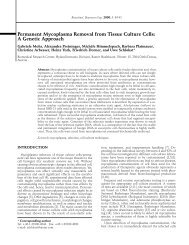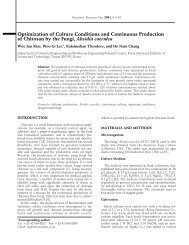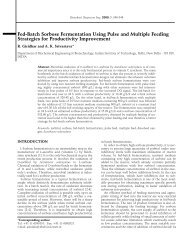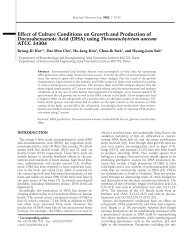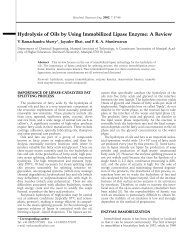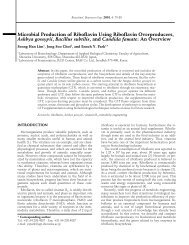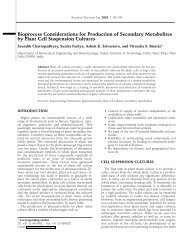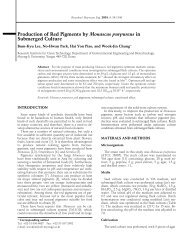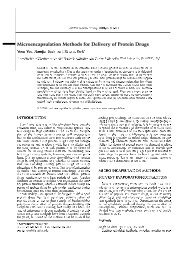Microencapsulation Methods for Delivery of Protein Drugs
Microencapsulation Methods for Delivery of Protein Drugs
Microencapsulation Methods for Delivery of Protein Drugs
You also want an ePaper? Increase the reach of your titles
YUMPU automatically turns print PDFs into web optimized ePapers that Google loves.
Biotechnol. Bioprocess Eng. 2001, Vol. 6, No. 4 225<br />
Carbon<br />
dioxide<br />
Pump<br />
Precipitation<br />
vessel<br />
13. Schematic diagram <strong>of</strong> the SAS method. From refer-<br />
Fig.<br />
[111]. ence<br />
common supercritical solvents toward the high mo-<br />
<strong>of</strong><br />
weight polymers and the solutes <strong>of</strong> therapeutic<br />
lecular<br />
such as proteins has restricted RESS to a<br />
importance<br />
low molecular weight polymers and a limited range<br />
few<br />
drugs, e.g., lovastatin [107,112]. Lovastatin was dis-<br />
<strong>of</strong><br />
in supercritical CO2 together with DL-PLA and<br />
solved<br />
subjected to RESS. The morphology <strong>of</strong> the copre-<br />
then<br />
product was found to be very sensitive to the<br />
cipitation<br />
amounts <strong>of</strong> drug and polymer, ranging from<br />
relative<br />
networks at high drug loading to drug<br />
bicontinuous<br />
encapsulated within polymer at low drug load-<br />
needles<br />
ings.<br />
has been applied to protein drugs <strong>for</strong> size reduc-<br />
SAS<br />
[113] and bioerodible polymers <strong>for</strong> microencapsulation<br />
<strong>of</strong> pharmaceuticals in a polymer matrix [114]. Retion<br />
this technique was used to produce PLGA microcently,<br />
containing lysozyme [115]. PLGA in dichlorospheres<br />
solution with suspended lysozyme was<br />
methane<br />
into a CO2 vapor phase through a capillary<br />
sprayed<br />
to <strong>for</strong>m droplets which solidified after falling<br />
nozzle<br />
a CO2 liquid phase. In this study, several problems<br />
into<br />
encountered in SAS process were overcome.<br />
previously<br />
size (70 µm) large enough to encapsulate pro-<br />
Particle<br />
particles was achieved by delayed precipitation ustein<br />
CO2 vapor phase above a CO2 liquid phase. Aggloing<br />
due to plasticization <strong>of</strong> the polymer by CO2 meration<br />
minimized at the optimum temperature <strong>of</strong> –20 was oC. many proteins are insoluble in organic solvents<br />
Since<br />
are less likely to be denatured when suspended, this<br />
and<br />
can be extended to other proteins.<br />
method<br />
Advantages and Limitations<br />
Pump<br />
Expansion<br />
vessel<br />
Polymer<br />
solution<br />
Vent<br />
Solvent<br />
fluids, particularly CO2 <strong>of</strong>fers various<br />
Supercritical<br />
when compared with widely used organic<br />
advantages<br />
It is relatively non-toxic, environmentally ac-<br />
solvents.<br />
non flammable, and inexpensive. In general,<br />
ceptable,<br />
with narrow size distribution can be achieved<br />
particles<br />
supercritical fluid methods. Potential advantages<br />
using<br />
include mild process temperatures, the potential <strong>for</strong><br />
also<br />
and the possibility <strong>for</strong> aseptic preparation <strong>of</strong><br />
scale-up<br />
6. Examples <strong>of</strong> micorencapsulation <strong>of</strong> maromolecular<br />
Table<br />
by IG/PEC<br />
drugs<br />
<strong>Protein</strong><br />
Salmon<br />
calcitonin<br />
IG/PEC<br />
system<br />
Encapsulation<br />
efficiency<br />
Particle<br />
size<br />
Chitosan-TPP 54-59% 0.9 mm<br />
Insulin Chitosan-TPP > 87%<br />
Bovine<br />
albu-<br />
serum<br />
min<br />
Dextran<br />
Horseradish<br />
preoxidase<br />
Chitosan/<br />
PEO/PPO-<br />
TPP<br />
Alginate-<br />
Calcium-<br />
Chitosan<br />
carrageenan<br />
ι<br />
amines -<br />
with Varies<br />
<strong>for</strong>mulations<br />
49-89%<br />
(depend-<br />
1-72%<br />
on amine<br />
ing<br />
employed)<br />
300-400<br />
nm<br />
200-1000<br />
nm<br />
-1.07 0.91<br />
mm<br />
50 µm<br />
Release kinetics Ref.<br />
burst (





